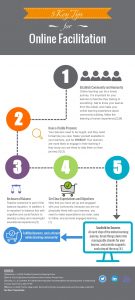Please Click the image above to see the infographic in a higher resolution. (My attempts to embed HTML did not work 🙁 )
The most important tip for effective online facilitation is to create a sense of community. Online learning environments (OLEs) can be isolating. An effective online community can combat this issue and lead to enriching educational experiences. According to Boetcher (2013), community building should be equal parts social, teaching and cognitive/content presence. Creating small peer feedback groups, and having learners complete introductory identity activities can help to build this community, which can then serve as a support system once the course begins. In addition, the peer to peer and learner to facilitator relationships advocated by Boetcher help to build community, but also engagement. This also helps to promote facilitator presence.
Effective online facilitation is significantly different than face to face learning experiences. Approaching online facilitation with the mentality of a traditional classroom facilitator is a recipe for failure. As Bull (2013) notes, an online facilitator needs to take on many roles to be successful including cheerleader, social butterfly, learning coach, and valve control. Wearing these various “facilitator hats”, the effective online facilitator can create a meaningful and engaging learning experience by being present in any number of these roles, and by just embracing the change from traditional teaching methods that teaching in this manner demands.
Online learners face the challenge of motivation and consistent engagement. Both of these aspects are likely to suffer further without the engaged management of learning from the facilitator. It is important to balance cognitive and social factors in learning to compliment instructor presence. Dunlap and Lowenthal (2013) found that supporting student success, clear and relevant content presentation, encouraging a supportive learning community, and being flexible as an educator were key. A challenge that exists here is the lack of pedagogical expertise, in university instructors in particular, who have relied on traditional content knowledge to lead their courses (Ammenworth, 2017). The need now is to be flexible and able to assume the variety of roles Bull (2013) advocates, and balance student cognition strategies (like cognitive load theory) with a guided presence that encourages students to engage in the OLE, and drive their own learning. Boettcher (2013) also suggest a range of asynchronous and synchronous activities, and variety in general activity types. The idea here is that learners maintain engagement, and begin to learn to take academic risks as they become more comfortable in their learning.
Clear instruction is important in any kind of learning, but when the instructor is not on hand to clarify, it is paramount. Learners need to know what they are learning and why. Online learning is also more effective when the process of learning is scaffolded. As such, these two elements work more closely that the others. Successful OLEs break down the stages of learning into manageable chunks, which gradually build the confidence of the learner (Salmon, 2018). This includes providing a variety in learning activities, as well as clear direction as to how to complete the activities. In this way, these last two elements pull together all key strategies mentioned here, as gradually easing learners into the course with simple get to know you activities is an example of both scaffolding, and community building.
References
Ammenwerth, E. (2017). Envisioning changing role of university teacher in online instructional environments. AISHE-J: The All Ireland Journal of Teaching and Learning in Higher Education, 9(3).
Boettcher, J. (2013). Ten Best Practices for Teaching Online Quick Guide for New Online faculty. Retrieved September 15, 2018, from http://www.designingforlearning.info/services/writing/ecoach/tenbest.html
Bull, B. (2013). Eight Roles of an Effective Online Teacher. Retrieved September 15, 2018, from http://www.facultyfocus.com/articles/online-education/eight-roles-of-an-effective-online-teacher/
Dunlap, J. C., & Lowenthal, P. R. (2018). Online educators’ recommendations for teaching online: Crowdsourcing in action. Open Praxis, 10(1), 79–89. https://doi.org/10.5944/openpraxis.10.1.721
Salmon, G. (2018). The five-stage model. Retrieved September 15, 2018, from https://www.gillysalmon.com/five-stage-model.html
